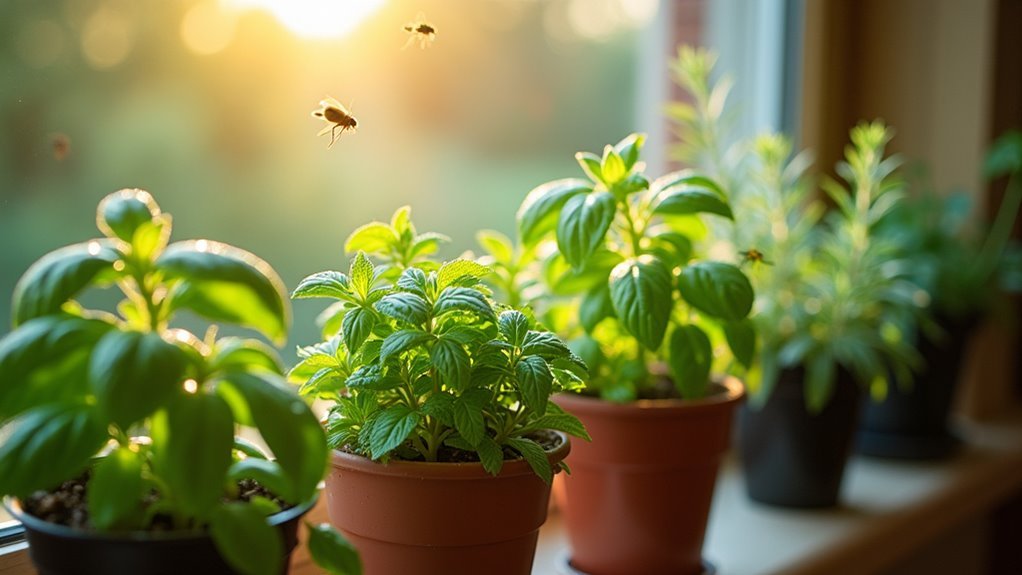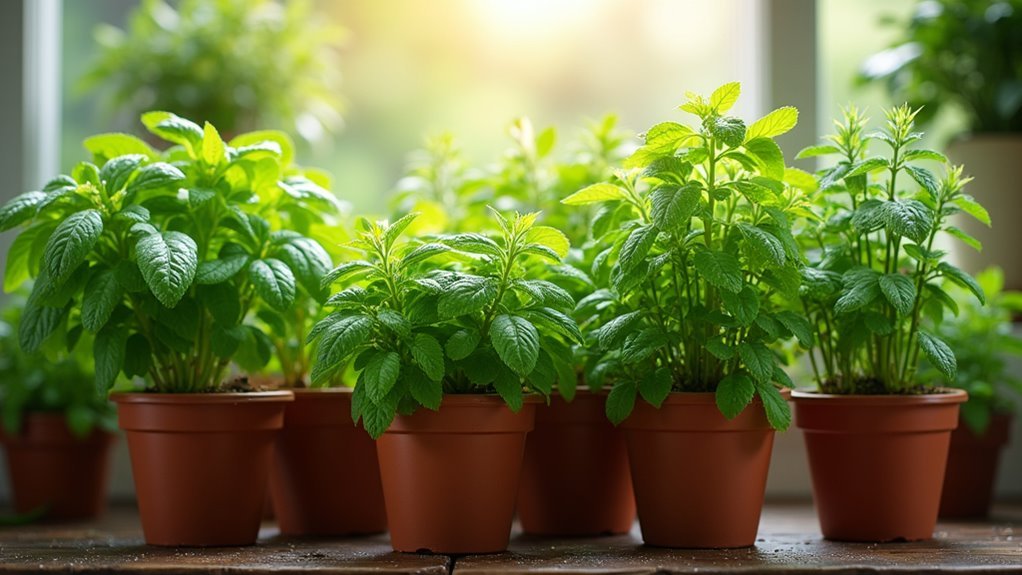You can effectively repel indoor flies by growing basil, lavender, mint, lemon balm, and sage in your home. These herbs release essential oils and compounds that confuse flies’ sensory systems, creating an invisible barrier against pest invasions. Place potted herbs near windows, doorways, and kitchen areas where flies typically enter. Crush the leaves occasionally to amplify their aromatic effects. With proper care including adequate sunlight and regular pruning, you’ll discover additional strategies to maximize their pest-deterrent potential.
Best Herbs That Naturally Repel Flies Indoors

The right herbs can transform your home into a natural fly-free zone while adding fresh scents and greenery to your living spaces.
These indoor plants work as powerful deterrents while serving double duty as culinary ingredients.
Basil stands out with its strong aroma that effectively repels flies. You’ll love growing it on windowsills where it’s easily accessible for cooking.
Basil’s powerful aroma naturally deters flies while providing fresh herbs for your kitchen right from your windowsill.
Lavender’s potent essential oils create a calming atmosphere while keeping flies away, thriving in bright locations or as dried arrangements.
Mint provides invigorating fragrance that acts as a fly barrier and grows well in small pots with moderate sunlight.
Lemon balm releases lemony scents flies dislike, thriving in partial sunlight.
Sage’s earthy smell repels various insects and flourishes in sunny indoor spots.
How Fly-Repellent Plants Work to Deter Pests
Your herb plants don’t just sit there looking pretty—they’re actively working as natural pest control systems.
These plants release specific compounds and essential oils that flies find absolutely repulsive, creating an invisible barrier around your home.
The strong scents confuse flies’ sensory systems, making them unable to navigate properly and forcing them to seek friendlier territory elsewhere.
Natural Compounds Deter Flies
When flies encounter certain plants, they’re met with a powerful arsenal of natural compounds that effectively turn them away. These herbs to grow in your garden release essential oils and potent fragrances that confuse flies’ sensory systems, making your space uninhabitable for them.
| Plant | Active Compound | Fly-Repelling Power |
|---|---|---|
| Lavender | Linalool | High |
| Basil | Eugenol | Very High |
| Mint | Menthol | High |
| Lemon Balm | Citronellal | Moderate |
| Rosemary | Camphor | High |
Plants that deter flies work through multiple mechanisms. Some release volatile oils that overwhelm flies’ olfactory receptors, while others produce sticky textures that create physical barriers. These natural compounds don’t just repel one or two flies—they create an invisible shield around your home, protecting your family from persistent pest invasions.
Scent Mechanisms Confuse Insects
Behind this chemical warfare lies a fascinating sensory disruption system that targets flies’ most critical navigation tools. When you grow fly-repellent plants, their crucial oils create aromatic barriers that scramble insects’ sensory perception. These natural compounds interfere with flies’ ability to detect food sources and locate potential mates, fundamentally blind-folding their chemical radar systems.
You’ll notice that crushing leaves amplifies this effect, releasing concentrated aroma compounds that enhance confusion in indoor environments. The scent molecules saturate the air, overwhelming flies’ olfactory receptors and making your space unappealing.
However, proximity matters greatly – placing plants strategically near entry points and problem areas guarantees ideal coverage. Air circulation patterns also influence effectiveness, so you’ll want to position your herb arsenal where natural airflow can distribute these repelling compounds throughout your living spaces.
Optimal Placement Strategies for Maximum Effectiveness

Since flies typically enter homes through windows and doorways, you’ll want to position your potted herbs like basil, mint, and lavender directly in these entry points to create an effective natural barrier.
For ideal placement of your repellent plants, place containers of lemon balm and catnip in kitchen areas where their strong aroma deters indoor flies attracted to food zones.
Maximize your space by using hanging pots or wall-mounted planters for marigolds and rosemary. This keeps surfaces clear while enhancing air circulation around your herbs.
Group multiple fly-repellent plants together in high-traffic areas, as combined fragrances amplify their effectiveness. However, don’t overcrowd them – proper spacing guarantees better aroma release and maintains the herbs’ pest-repelling power throughout your home.
Growing and Caring for Indoor Fly-Repelling Herbs
You’ll need to create the right environment for your fly-repelling herbs to thrive and release their natural pest-deterring oils effectively.
Focus on providing adequate sunlight, proper drainage, and strategic positioning to maximize their repelling power.
Regular maintenance like pruning and careful watering will keep your herbs healthy and their aromatic properties strong.
Optimal Growing Conditions
While growing fly-repelling herbs indoors requires attention to specific conditions, you’ll find success by providing well-drained soil and at least six hours of daily sunlight.
These indoor fly-repelling herbs need ideal growth conditions to effectively release their natural essential oils that deter pests.
Water your herbs according to their specific needs—mint thrives with consistently moist soil, while lavender requires drying periods between waterings to prevent root rot.
You’ll want to guarantee good air circulation around your plants to promote healthy development and enhance their pest-repelling effectiveness.
Use pots with drainage holes to prevent water accumulation.
Regular pruning and harvesting encourages bushier growth while releasing more essential oils.
This regular watering and maintenance routine maximizes your herbs’ fly-repelling properties while keeping them healthy and productive indoors.
Maintenance and Care
Maintain your indoor fly-repelling herbs with consistent care to maximize their pest-deterring potential. Water your herbs regularly, keeping soil moist but not waterlogged to guarantee ideal growth and fragrance release.
Prune herbs like rosemary and lavender to encourage bushiness and enhance their aromatic properties that effectively repel flies. Position pots near windows and doorways to create natural barriers against indoor pests.
Monitor your herbs closely for signs of disease or pest damage, as healthy plants maintain stronger fly-deterring capabilities. Remove affected leaves immediately to prevent spread.
Consider repotting every one to two years, providing fresh soil and adequate growing space. This guarantees your herbs remain vibrant and continue serving as effective natural repellents throughout your home.
Combining Herbs With Other Natural Fly Control Methods

Although fly-repellent herbs work well on their own, you’ll achieve better results by combining them with other natural control methods.
Enhance your indoor fly control strategy by pairing herbs like basil, lavender, and mint with essential oil sprays to create stronger scent barriers that effectively repel flies.
Crush leaves from rosemary and catnip in areas where flies gather, releasing concentrated essential oils for maximum impact.
Position herb pots strategically near windows and doorways while integrating fly traps to target both attraction and repulsion.
Maintain cleanliness by sealing food and removing trash regularly, as herbs work best in clean environments.
Rotate your fly repellent herbs’ placement seasonally to adapt to changing fly behaviors and maintain peak natural repelling effectiveness throughout your home.
Safety Considerations for Pets and Children
When growing herbs indoors to repel flies, you must consider the safety of your household members, particularly children and pets who may interact with these plants.
Most fly-repellent herbs like basil, lavender, and mint are safe when used properly, but you’ll need to monitor curious children and pets around plants like catnip and mint, as they may try nibbling them.
While most fly-repelling herbs are generally safe, monitor children and pets who may be tempted to nibble on catnip and mint plants.
Some herbs, including pennyroyal, become toxic if ingested in large amounts. Research each plant’s potential effects since individual sensitivities vary.
Consultation with your veterinarian is recommended, especially if your pets tend to chew plants.
Implement precautionary measures by keeping potentially harmful plants out of reach or using barriers to prevent accidental ingestion and address safety considerations effectively.
Common Mistakes to Avoid When Using Repellent Plants
Despite their natural effectiveness, many people inadvertently reduce their herb plants’ fly-repelling capabilities through common care mistakes.
Overwatering herbs causes root rot and diminishes their repellent strength, so guarantee proper drainage.
You’re also missing out if you don’t crush or bruise the leaves regularly—this releases essential oils that actually deter flies.
Without regular maintenance and pruning, your plants become leggy and lose aromatic potency.
Don’t place repellent plants too far from entry points; position them near windows and doors for maximum impact.
Finally, avoid relying solely on herbs for fly control.
You’ll achieve better results using an integrated approach that combines repellent plants with other fly management methods.
Enhancing Herb Effectiveness Through Proper Maintenance
Since proper maintenance directly impacts your herbs’ fly-repelling power, you’ll need to establish a consistent care routine that maximizes their natural defenses.
Keep your repellent plants healthy by trimming basil and mint regularly to encourage bushier growth and release more essential oils that deter flies. Make sure herbs like rosemary and lavender receive adequate sunlight to enhance their potency.
Maintain proper moisture levels for lemon balm and mint to prevent plant stress and promote ideal growth. Monitor your plants for pest infestations and address issues promptly to preserve their effectiveness.
As herbs grow larger, re-pot them to improve root development and nutrient access, strengthening their natural fly-repelling capabilities.
Frequently Asked Questions
What Herbs Get Rid of House Flies?
You can repel house flies by growing basil, lavender, mint, and lemon balm indoors. These herbs emit natural oils and strong fragrances that flies dislike, creating an effective barrier against these pests.
What Indoor Plant Keeps Flies Away?
You can place basil near your windows to repel flies with its strong natural oils. Lavender’s purple flowers and essential oils also deter flies while adding beauty to bright indoor spaces.
What Smell Keeps House Flies Away?
Strong herbal scents like basil, lavender, mint, rosemary, and sage naturally repel house flies. You’ll find lemon-scented compounds, especially citronellal from lemon balm, particularly effective at keeping these pests away from your living spaces.
What Is a Good Fly Repellent for Indoors?
You’ll find basil, lavender, mint, lemon balm, and marigolds work excellently as indoor fly repellents. Bruise their leaves regularly to release more essential oils, and place pots near windows for maximum effectiveness.
In Summary
You’ll find that growing fly-repelling herbs indoors offers a natural, chemical-free solution to pest control. Remember to place your plants strategically near entry points and guarantee they’re getting proper light and care. Don’t forget to crush or brush the leaves occasionally to release their oils. With consistent maintenance and the right herb combinations, you’ll create an effective barrier against flies while enjoying fresh herbs for cooking and natural home fragrance.





Leave a Reply